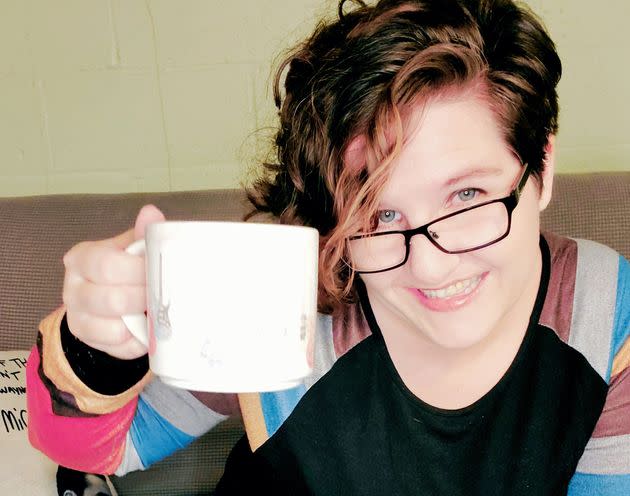These Parents Let Their Kids Determine Their Own Gender Identity. Here’s How It Works.
It’s often the first question you’re asked about your baby, posed before they’re even born: “Boy or girl?”
A growing number of parents, many of them — though not all — queer or transgender, are choosing to leave the answer up to their child. This means waiting until the child is old enough to declare their own gender identity, and often (but not always) using they/them pronouns until the child voices their own preference.
The concept of gender self-determination isn’t complicated, but navigating a gender-obsessed society rife with stereotypes isn’t easy. Still, parents who have chosen this path believe it’s worth weathering some discomfort to give their child access to the full spectrum of gender experience.
This practice, sometimes known as “gender-creative parenting,” isn’t about getting rid of pink and blue, or restricting kids’ options to shades of beige and gray that our culture hasn’t coded male or female. It’s about giving kids access to every color in the rainbow.
Gender-creative parenting goes beyond pronouns.
When Arlo Dennis gave birth to their second child, Sparrow, six years ago, they and their partners (Dennis is in a polyamorous relationship) decided not to announce the baby’s sex and to use they/them pronouns for Sparrow. It was a choice they arrived at before Sparrow was even conceived.

Arlo Dennis and their child Sparrow.
“Very early on, it just kind of was an obvious conclusion for us,” Dennis, a Florida resident, told HuffPost.
Dennis and their partners also have an older child, 12-year-old Hazel, who was identified as female at birth and addressed with she/her pronouns. But around age 4, Hazel began to explore their own gender identity and decided to change their pronouns. This prompted their parents to pursue a different path when handling the question of Sparrow’s gender.
Critics say that gender-creative parents are imposing their own agenda onto children. But Dennis and members of other families told HuffPost that what they are actually doing is freeing their kids from people’s gendered expectations.
“It’s the rest of the world — kids on the playground, parents at school, teachers, a stranger at the grocery store,” Dennis said. “They all are going to have different interactions with the child based on an assumption of the gender.”
This assumption can lead to differences in the way that people talk to children, such as calling a baby with a bow on its head “pretty” instead of “handsome.” There is even research showing that mothers interact physically in different ways with boy and girl babies, being more active physically with boys.
If you use they/them pronouns for your child, or let them wear clothing and play with toys that don’t “match” their assigned sex, some adults may assume a gender for your child and then act accordingly. Others may be flummoxed (or delighted) to encounter a child who isn’t adhering to all of the usual gender stereotypes.
As a result, Dennis said that Sparrow “is able to get a variety of experiences” with other people and their gendered assumptions. This allows them to identify which kinds of interactions feel right for them, so they can make decisions about their own gender identity.
“The goal is not to isolate them and have a gender-free experience. It’s to let them explore it all,” Dennis said, adding that using they/them pronouns “facilitates that” for Sparrow. Dennis coined the term “antegender” to talk about the period before a child understands the concept of gender and can claim an identity, which usually happens around age 3.
Now 6, Sparrow uses she/they pronouns, and their gendered experiences out in the world are a topic of conversation at home. For example, when Sparrow commented that a child on the playground identified them as a girl and Dennis asked how it felt, Sparrow responded that they went along with this gendering to get back to playing.
“They’re so astute, they’re so mature in their understanding of things,” Dennis observed.
Sparrow’s gender-expansive views, however, aren’t shared by others in their home state. To escape an increasingly hostile political environment and a slate of anti-trans bills signed by Florida Gov. Ron DeSantis (R), the family plans to relocate to Maryland, where Sparrow will have the option to talk at kindergarten about being nonbinary or having trans parents.
Parenting outside the gender binary can provide options for kids and be freeing for parents, too.
Iris and Tori Saunders are a couple raising their 1-year-old child in a gender-creative way in Washington, D.C.
One of their posts on Instagram, where they are documenting their story, lists several responses they give when people ask about their child’s gender. One they like to use with kids, they write, is: “We don’t know! They’ll tell us who they are one day.”

Iris and Tori Saunders with their baby.
The Saunders told HuffPost in an email that they parent this way to give their child “the autonomy that we didn’t have as kids. Giving them the whole world instead of half of it. Encouraging them to express themselves in ways that are not limited by the traditional social construct of gender. It is not getting rid of gender — it’s giving them all of it.”
New York-based Rebecca and her partner, Alana, who run the Be Yourself Bookshop, are another couple who identify as gender-creative parents. To them, this means “educating young kids about gender diversity so they can grow up to be their most authentic self,” said Rebecca, who asked for her full name to be withheld for privacy reasons.
Their goal is “to create a welcoming and affirming home environment so they would know there is no one way to be, and who you are changes over time and that’s OK,” she added. Parenting in this way has helped her realize “how much gender expression is forced on kids at young ages.”
Dennis said this is a load that they personally don’t have to bear. “I see a lot of people who haven’t taken on this kind of philosophy carry a great burden of gender education,” Dennis said. In contrast, they added, “I’m able to just hand my kid any toy off the shelf that they think is cool.”
For parents who identify as trans, queer or gender-nonconforming, there can be a healing aspect to providing your own child something that you needed but didn’t have.
“In both of our childhoods we were told that we were, and had to be, ‘one thing,’” the Saunders wrote to HuffPost. “We did not want to make that decision for our child. We wanted to allow them the space to explore and tell us who they are instead of the other way around.”
Gender-creative parenting is in line with other child-centered parenting philosophies.
Dennis sees gender-creative parenting as dovetailing with other “parenting philosophies that really honor the autonomy and the personhood of children,” which these days are often referred to as “gentle parenting.”
Like with giving children control over what and how much they are going to eat, gender-creative parenting teaches kids to respect their own instincts and what feels true for them.
With millennial parents and others, Dennis said, they see “a lot of unpacking of trauma,” and a movement toward “this idea that we all know ourselves best.”
“It’s so simple a principle, but I think it’s really a valuable one,” they continued.
Free from the baggage of others’ expectations, kids can pursue their own gender identity and a wide range of possible interests. Gender-creative parenting gives trans kids space to come out, and can allow a boy to pursue ballet or cry when he is sad, and a girl to excel in math, science or sports.
“Hand the reins over to your child and let them take the lead,” wrote the Saunders. “You will be so in awe of what you’ll discover about them when gendered boundaries are taken down.”
Parenting in this way doesn’t look the same in every household — it’s flexible.
If the idea of explaining your baby’s pronouns to everyone you meet sounds exhausting or even unsafe, there are other ways to keep the spectrum of gender possibilities open for your child.
“It doesn’t have to be all or nothing,” Dennis said. If, for example, your mother-in-law insists on using a binary pronoun, or you decide to use they/them at home but not at day care, all is not lost.
“The goal is not militant perfection on pronouns,” Dennis said. “The goal is to let the kid be who they want to be.”
The Saunders concurred. “There are plenty of folks out there who follow a gender open concept while using gendered pronouns for their child(ren),” they wrote.
Maybe you use they/them pronouns in one safe space, or you work on not automatically gendering new people you meet so that they know you understand gender is not always a given.

New York resident Rebecca has chosen to parent in a gender-creative way.
“It’s never too late to start,” Rebecca said. “Allowing kids a multitude of choices for their own gender expression has a huge impact.”
She added, “Teach safety and boundaries first, especially if you live in an unsafe area, but always have a place for them to be themselves.”
Exposure to people who challenge stereotypes or exist outside the gender binary is another important way to embrace this philosophy, according to Caroline Carter, a psychologist who works with trans and gender-nonconforming kids and the author of the children’s book “Every Body Is a Rainbow.”
This can happen via “experiences within gender-diverse communities where children can see and experience the many embodiments possible for gender,” she said.
Carter referred to images as “a child’s first language” and underscored the importance of picture books for toddlers and preschoolers. She recommended the “We Are Little Feminists” series of board books about families and other topics as a good source of diverse images.
Meanwhile, Rebecca recommended the titles “It Feels Good To Be Yourself,” “From the Stars in the Sky to the Fish in the Sea” and “What Are Your Words?” to help kids think about gender identity.
Another potential place to begin is allowing and encouraging your child to follow their preferences, even when they fall outside of the gender binary.
“Start allowing your kids to pick out their own clothes, hairstyle, toys, activities, and sports,” wrote the Saunders. “Introduce them to books and media with gender diverse representation. Model exploration and breaking gender roles in your own home and family.”
Dennis sees this last point as critical. In addition to providing all options for toys and clothes, they said, “parents should explore gender and they should model exploring gender. If you are cisgender, that’s great. Still, play with gender, play with identity, explore, ask questions.”
Queer parents aren’t off the hook, either. “You still have to do intentional work to deconstruct, and you still have to do the work to make community,” said Dennis.
Rebecca explained that she sees her own discomfort as a sign that she’s on the right track: “Dismantling my millennial foundations of gender shouldn’t feel comfortable. This is how we know we’re creating change.”
It’s important to find a community that can support you in this journey.
Gender-creative parents will often be met with confusion and resistance — in addition to a volatile political climate.
“Gender-creative parenting is one of the most culturally counter maneuvers a parent can make during one of the most ‘gendered’ times in a child’s life,” Carter said.
She suggested that parents seek out community that offers them the support they need to withstand these challenges. “You need spaces where you feel a part of a majority (even if a small space), where your values are the dominant ones,” she said.
If you choose to parent in this way, it’s not uncommon to have your own moments of doubt around whether you’re doing the right thing. In her experience, Carter said, families often experience this when they’re in a place of fear — which, she added, “completely makes sense ... given that this feeling inevitably would come up when going against one of the strongest systems of cultural meaning-making in Western culture.”
This is where community plays a vital role, she explained. “Understanding and empathy are the antidote for fear. They literally help regulate our nervous systems,” she said. “We need to be with others who have been in our shoes.”
Whether you’re confronted at the playground by a parent who thinks you shouldn’t let your son wear a dress, or you’re trying to draw boundaries with extended family about who is allowed to change the baby’s diaper (to limit who knows what their genitals look like), families facing similar challenges are best equipped to offer the support you need.
Carter also recommended establishing a mindfulness practice to help you cope with these moments of stress. “When parents experience interpersonal judgment or self-doubt, I encourage them to simply be mindful or aware of the feeling they are experiencing and not judge it,” she said. “Pausing and noticing the feeling creates a little space and takes away some of its power.”
Cultivating compassion is another way to deal with both your own discomfort and criticism from others. It “reframes the other person’s judgment as coming from a place of fear and misunderstanding,” Carter said. “It can additionally be seen as their own inner judgment projected out — i.e., ‘hurt people hurt people.’”
While you are allowed to draw boundaries for your own family, and under no obligation to educate everyone who questions your parenting, “a compassion practice can prime us for the times where there may be opportunities to lovingly build awareness in others,” Carter said.
